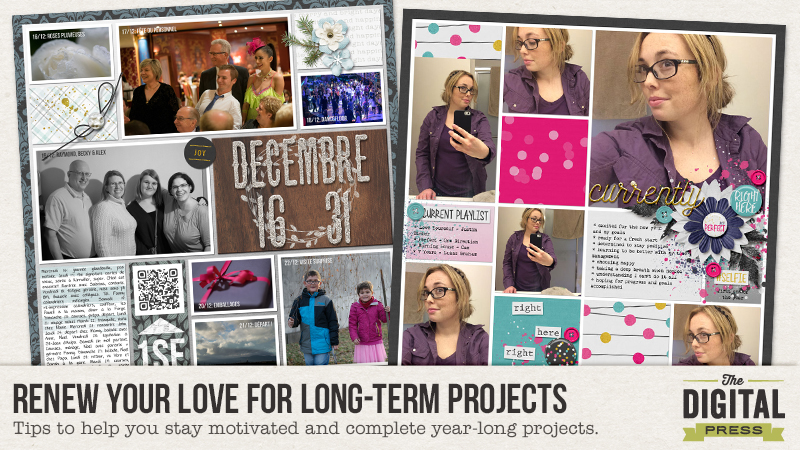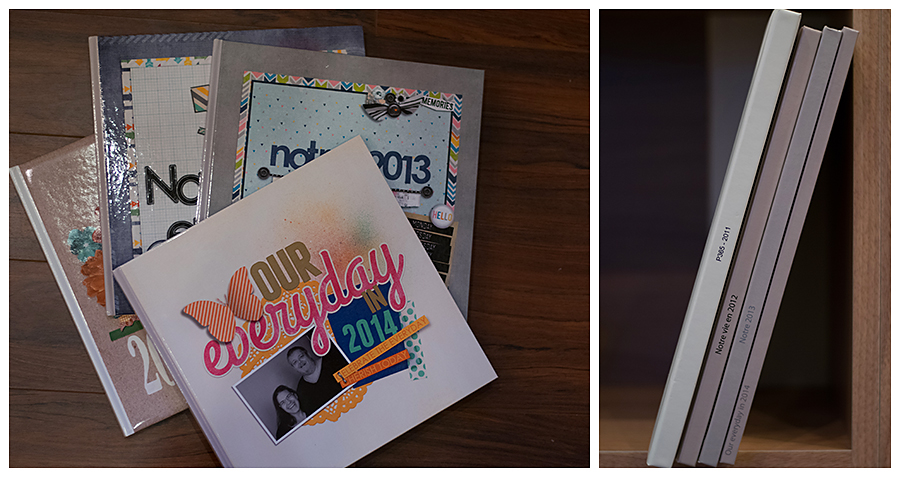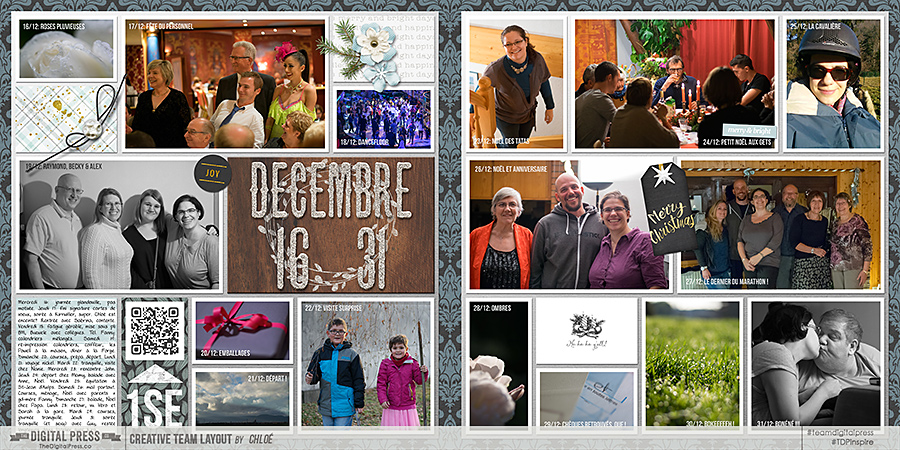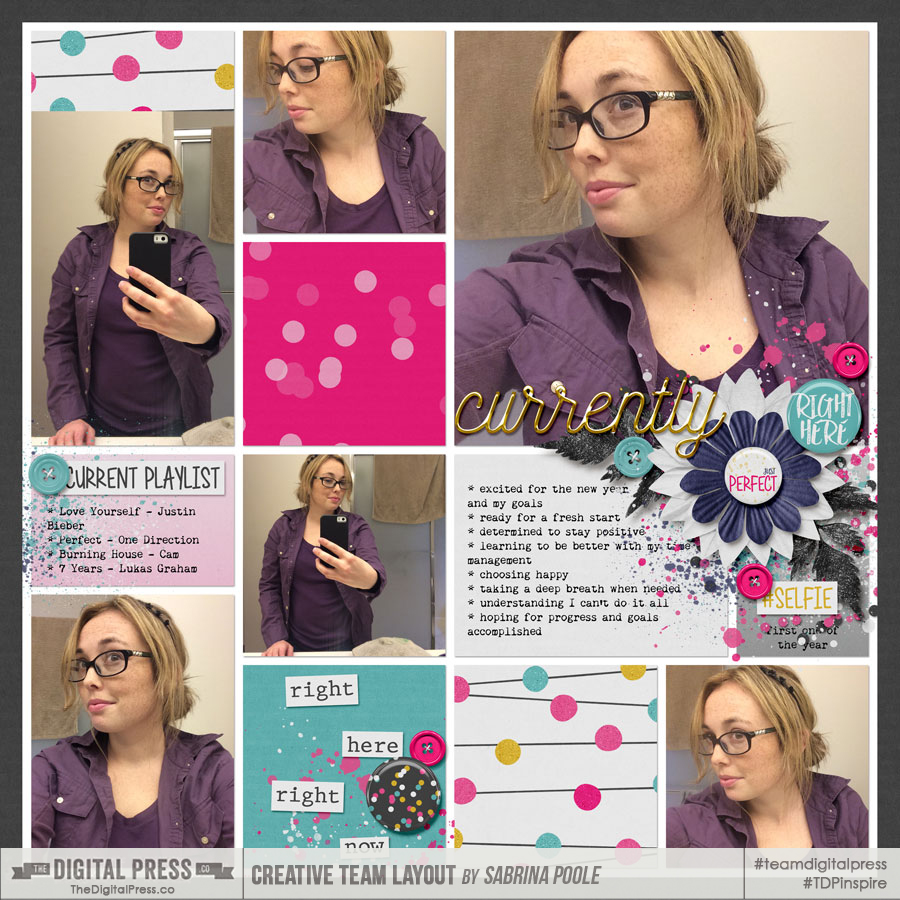
We scrappers usually love long term projects. They bring this comforting feeling that come with routine and habits, without mentioning the joy of recording those memories… but they can also be challenging at times!
These sorts of projects come in all shapes and forms:
- Everyday/Photogaphy-Centered Projects: pocket-scrapping (Project Life); Project 365 (P365; one photo a day); Project 52 (P52; one photo a week); Project 12 (P12; one photo a month). For example, here’s a look at my last layout from my P365 project in 2015:
- Themed Projects: All About Me (AAM; one page a week or month about yourself… with the mandatory selfie, of course!); “letter to my kid(s)” (or any other loved one); a year of _____ (fill in the blank; it could be about a hobby, about your pet, or about anything that you’re passionate about!); monthly resolutions-check up layouts; words of the month throughout the year, etc. This year, for instance, I plan to do such a page every month (in addition to my P365-ish) that contains a look at what happened, how I felt, how I progressed on my goals / resolutions, new things I learned, things that worked or didn’t work, etc. I think this will make for a great album! I haven’t started yet, but I found this gorgeous page by TDP creative team member Sabrina, which I found to be totally inspiring:
- Technique-Centered Projects: these would be about one technique or scrapping style, like Art Journaling layouts, ATCs, journaling-focused layouts, trying a new technique every month or week, hybrid projects, etc.
If you’re anything like me, you’ve probably started and stopped those projects many times over the years. For instance, you might have started an annual album — but now you have an unfinished pocket-style scrapbook project that is making you feel guilty. Well, first of all, please stop feeling guilty… right now! Even if you only have one page done, it’s one more page than nothing. It is still a documented memory! Put it in your book. And rather than focusing on the memories you “missed,” focus instead on the ones you did record. That is already amazing — and there’s no such thing as “failing” in memory-keeping!
I’ve completed everyday-type projects every year since 2011, and here are some tips that have helped me get through each of them:
- Knowing WHY I am doing the projects. When I’m clear about my motivations, it’s easier to keep going even when I am busy, when I lose my scrapping mojo, when I feel like my life is boring and not scrap-worthy. I’ve often scrapped those motivations and/or thoughts about the project, and used those as the first page in my photo book. It’s a fun way to make an intro to the album!
- Keeping things simple. The first 2 years, I used a template I created with a spot for the daily photo and some journaling, plus a journaling spot for extra info. That way, the planning and design was all done and I simply had to switch my photos from horizontal to vertical when needed… clip my papers, add a few elements, add my journaling… and I was done. I’ve since switched to pocket scrapping, and I’ve used actions (more on that later) to create personalized templates for each page that fit my photos perfectly. I also simplify things by using one kit or collection for the entire month… and the same fonts throughout the whole project (one for journaling, and one for the dates on my photos, and that’s it!). This not only helps me scrap faster (as I don’t have as many creative decisions to make), but it also brings some unity throughout my whole album when I get it printed.
- Trying to scrap regularly. It’s much easier to go through one or two pages at a time, rather than catch up and finish 5 months in a row. If you want to use your “big girl camera,” keep it as easy to grab as you can (just make sure little hands can’t grab it too easily! Gaaaah!). You’re way more likely to use it if it’s right next to you, than if you have to search for it or go grab it from somewhere far from where the action is happening.
- Automating things as much as possible. Technology is fantastic… let it help you! I’ve created actions in Photoshop to help me scrap my pages as quickly as possible. I originally started with a commercial use pocket-templates maker, and eventually tweaked it so that it not only creates the photo spots but also the double page spread, the background just like I like it, etc. I have another action to save the JPG and the web versions of both the double-spread and each page individually. Same goes for journaling: I use an app to record my journaling, and I’ve set up reminders every evening. When I forget to do it at night, I go through my social media accounts and my calendar to help me remember what happened (I have the worst memory ever!). I call my smartphone my second brain for a good reason: it’s an amazing tool to help me remember to take a photo, write down a few sentences about what happened that day, even record video (as I explained in a previous post here on the blog). Set up processes to upload your photos regularly, edit and rename them as you upload them, back them up (it goes without saying, right?), etc. Anything that helps you go faster through repetitive tasks is a great help!
- Let go of perfection and the guilt that comes with it. There is no such thing as a scrapping police! I used to call my projects “P365-ish” …because I do miss days here and there! If I can, I quickly change the date on my camera (that way the metadata shows the previous date too!) and take a picture for the day(s) I missed. And if I can’t, then so be it! No big deal! I’ve started many P365 projects over the years, taking my daily picture religiously for… 2 months, and I finally switched to a pocket-style project because I stopped taking daily photos. Again, no big deal. I’m getting memories recorded either way, right? I’ve had 2-page spreads with tons of photos for one week (especially for Christmas when a lot is going on), and other times I just have one page with only 2 photos for a 2 week period. I’m fine with it. I usually take photos with my DSLR, but I’m definitely OK with phone photos, too! The most important thing is to enjoy the project, both while doing it and when it’s completed.
- Don’t forget to print your pages! This is incredibly rewarding and I love to go through my books from the previous years. I usually wait to create them until there’s a sale because I love a great deal (who doesn’t, right?). Sometimes I buy a credit and use the deadline as a motivation to finish my pages (That’s what I did with my 2014 PL: I finished it in May 2015 since I had a credit for a book that I refused to lose! I’m pretty sure it wouldn’t be printed yet if it weren’t for the credit! LOL)

I hope those tips will help you enjoy one (or many!) long term project in 2016.
If you’re feeling inspired now… please head over to the forum where there’s a challenge to go along with today’s post!

About the author Chloé is in charge of PR and communication for her small town by day, and is a digiscrapper “by night” and a photographer whenever the light is beautiful. She lives with her man and fur-babies in a small town of Alsace (in the northeast of France), where she loves to read, watch good TV shows (TWD being her absolute favorite), and just hang out with her friends — no matter if they are close by, online, or away in her Swiss hometown.



One comment